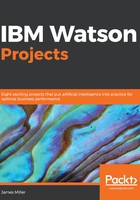
What this book covers
Chapter 1, The Essentials of IBM Watson, defines the latest version of (IBM) Watson Analytics and outlines various uses of the tool. In addition, the chapter provides an overview of Watson's interface and its major components, as well as offering a refresher on basic tasks such as adding data, exploring data, and creating a prediction.
Chapter 2, A Basic Watson Project, analyzes trip logs from a driving services company to determine which trip characteristics have a direct effect on a trip's profitability, what type of trip is most profitable, and which are prone to complications. This first project serves to cover the basics of a simple Watson project, preparing the reader for the upcoming, more complex projects presented in the following chapters.
Chapter 3, An Automated Supply Chain Scenario, consists of a use case project that focuses on analyzing how effective a supply chain is for a retail department store. This automated supply chain scenario provides insights into an organization's supply chain data and processes, in an attempt to isolate the cause of poor delivery performance.
Chapter 4, Healthcare Dialoguing, analyzes Watson's cognitive assistance solution, specifically with regard to creating an engaging dialog between healthcare providers and their patients. This project establishes relevant recommendations based upon patient inputs.
Chapter 5, Social Media Sentiment Analysis, tackles sentimental analysis using Watson to automatically analyze and categorize text posted to social media in an attempt to determine an audience's feeling about a topic.
Chapter 6, Pattern Recognition and Classification, discusses pattern recognition and using Watson to identify regularities in data in an effort to automatically classify athletes positionally based upon data provided.
Chapter 7, Retail and Personalized Recommendations, introduces the concept of personalized recommendations and the use of Watson to create a specialized plan through conversion. In this project, the objective is to create an individualized plan based upon characteristics found within a pool of data.
Chapter 8, Integration for Sales Forecasting, discusses integrating Watson with an organization's forecasting system in order to test its product sales forecasting effectiveness, comparing forecasts to actual results.
Chapter 9, Anomaly Detection in Banking with AI, uses Artificial Intelligence (AI) from a Watson perspective, walking through an example use case project related to the banking industry, in which transactions are evaluated to identify fraud.
Chapter 10, What's Next?, summarizes what readers have learned in the preceding chapters and what they can do next to continue the Watson learning process.